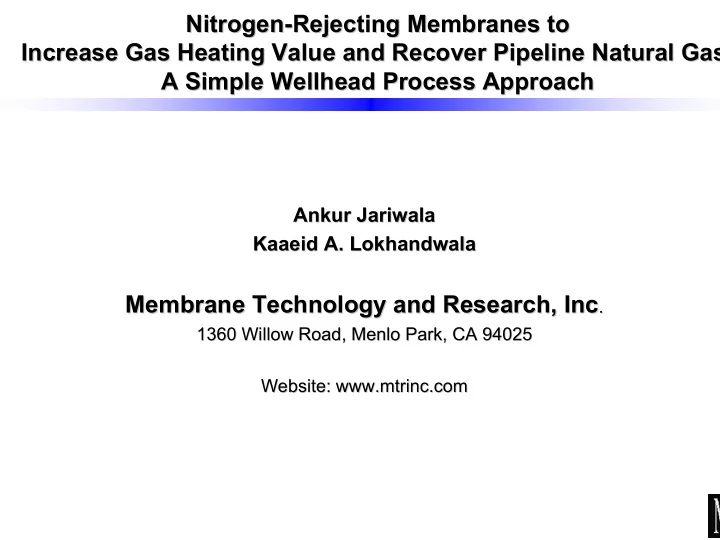

Nitrogen- -Rejecting Membranes to Rejecting Membranes to Nitrogen Increase Gas Heating Value and Recover Pipeline Natural Gas: Increase Gas Heating Value and Recover Pipeline Natural Gas: A Simple Wellhead Process Approach A Simple Wellhead Process Approach Ankur Jariwala Ankur Jariwala Kaaeid A. Lokhandwala Kaaeid A. Lokhandwala Membrane Technology and Research, Inc . Membrane Technology and Research, Inc . 1360 Willow Road, Menlo Park, CA 94025 1360 Willow Road, Menlo Park, CA 94025 Website: www.mtrinc.com Website: www.mtrinc.com
Outline Outline • Application – – • Application Recapturing CH 4 from Blow down of Nitrogen- - Recapturing CH 4 from Blow down of Nitrogen Foam Fractured Horizontal and Vertical Wells. Foam Fractured Horizontal and Vertical Wells. • Novel Composite Membranes • Novel Composite Membranes • Why a Membrane Process for this Application ? • Why a Membrane Process for this Application ? • Process Designs and Economics • Process Designs and Economics • Conclusions • Conclusions
High Rate Nitrogen- -Rich Rich Blowdown Blowdown Operation Operation High Rate Nitrogen in Nitrogen- -Foam Fractured Horizontal Wells Foam Fractured Horizontal Wells in Nitrogen
High Rate Nitrogen- -Rich Rich Blowdown Blowdown Operation Operation High Rate Nitrogen in Nitrogen- -Foam Fractured Horizontal Wells Foam Fractured Horizontal Wells in Nitrogen
Membrane Separation Mechanism Membrane Separation Mechanism A membrane can separate A membrane can separate components of a gas mixture components of a gas mixture due to differential permeation rates due to differential permeation rates across a non- across a non -porous polymer film porous polymer film resulting in a differential pressure resulting in a differential pressure driving force. driving force. Permeability = Diffusivity * Solubility Permeability = Diffusivity * Solubility (P) (D) (S) (P) (D) (S) Membrane Selectivity Membrane Selectivity MTR’s Rubbery Membranes MTR’s Rubbery Membranes P 1 D 1 . S 1 P D 1 . S Reject Nitrogen Reject Nitrogen 1 1 = and Permeate Hydrocarbon and Permeate Hydrocarbon P 2 D 2 . S 2 P D 2 . S Components 2 2 Components
Glassy versus Rubbery Membranes Glassy versus Rubbery Membranes Glassy Membranes Glassy Membranes Fast Gas Fast Gas Slow Gas Slow Gas Nitrogen Nitrogen Ethane Ethane Hydrogen Hydrogen Hexane Hexane H 2 H 2 O O CO 2 CO Methane Methane Propane Propane 2 Rubbery Membranes Rubbery Membranes (MTR Technology) (MTR Technology) Fast Gas Slow Gas Fast Gas Slow Gas Ethane Ethane Methane Methane Hexane Hexane Nitrogen Nitrogen H 2 O Propane CO 2 Hydrogen H 2 O Propane CO Hydrogen 2
Membrane System Installations Membrane System Installations Membranes are a Mature Separation Technology Membranes are a Mature Separation Technology Gas/Gas Separation Systems Gas/Gas Separation Systems H 2 /N 2 , CH 4 ~ 200 Units H 2 /N 2 , CH ~ 200 Units 4 O 2 O 2 /N /N 2 ~ 5,000 Units ~ 5,000 Units 2 CO 2 /CH 4 ~ 200 Units CO 2 /CH ~ 200 Units 4 Vapor/Gas Separation Systems (MTR’S Reference Base) (MTR’S Reference Base) Vapor/Gas Separation Systems Hydrocarbon/N 2 , CH 4 ~ 100 Units Hydrocarbon/N 2 , CH ~ 100 Units 4
MTR Membrane in Spiral Wound Cartridges MTR Membrane in Spiral Wound Cartridges
Typical Commercial Skid- -Mounted Unit Mounted Unit Typical Commercial Skid NTE Membrane System Design Flow Rate-1.0 MMSCFD Twin Bottoms Membrane System Design Flow Rate-0.2 MMSCFD
Proven Long- -Term Separation Efficiency Term Separation Efficiency Proven Long (400 years Cumulative Operating Experience with (400 years Cumulative Operating Experience with Silicone Rubber Membrane) Silicone Rubber Membrane)
Process Flow Diagram for Vertical Wells Process Flow Diagram for Vertical Wells
Process Scheme for High Nitrogen Feed Gas Process Scheme for High Nitrogen Feed Gas from Horizontal Wells from Horizontal Wells
Nitrogen Rejection – – Application Envelope Application Envelope Nitrogen Rejection • Inlet nitrogen content between 4 and 30 vol vol% % • Inlet nitrogen content between 4 and 30 • Inlet flow rate between 0.1 – – 20 MMSCFD 20 MMSCFD • Inlet flow rate between 0.1 • Discharge N 2 specification between 4 and 8 vol vol% % • Discharge N 2 specification between 4 and 8 • Upgrading to pipeline acceptability • Upgrading to pipeline acceptability • Upgrading fuel gas to meet heating value for burning • Upgrading fuel gas to meet heating value for burning • Hydrocarbon removal for nitrogen re- -injection injection • Hydrocarbon removal for nitrogen re • Mobile units can be manufactured easily • Mobile units can be manufactured easily
Advantages of Membrane Systems Advantages of Membrane Systems • Simple passive system • Simple passive system • High on- -stream factor (typically > 98%) stream factor (typically > 98%) • High on • Minimal or no operator attention • Minimal or no operator attention • Small footprint, low weight • Small footprint, low weight • Large turndown ratio • Large turndown ratio • Low maintenance • Low maintenance • Lower capital and operating costs • Lower capital and operating costs • Units are mobile. No foundation required. Level gravel • Units are mobile. No foundation required. Level gravel or soil is adequate for membrane skid. or soil is adequate for membrane skid.
Other Oil & Gas Applications Other Oil & Gas Applications Other Applications in the Oil & Gas Industries for MTR’s Reverse- - Other Applications in the Oil & Gas Industries for MTR’s Reverse Selective Membranes Selective Membranes Gas : Gas : Fuel gas conditioning Fuel gas conditioning NG Dew point Control NG Dew point Control NGL recovery NGL recovery Natural gas dehydration. Natural gas dehydration. Oil : : Associated gas processing Oil Associated gas processing Vapor recovery from storage tanks and ship vents. Vapor recovery from storage tanks and ship vents.
Recommend
More recommend